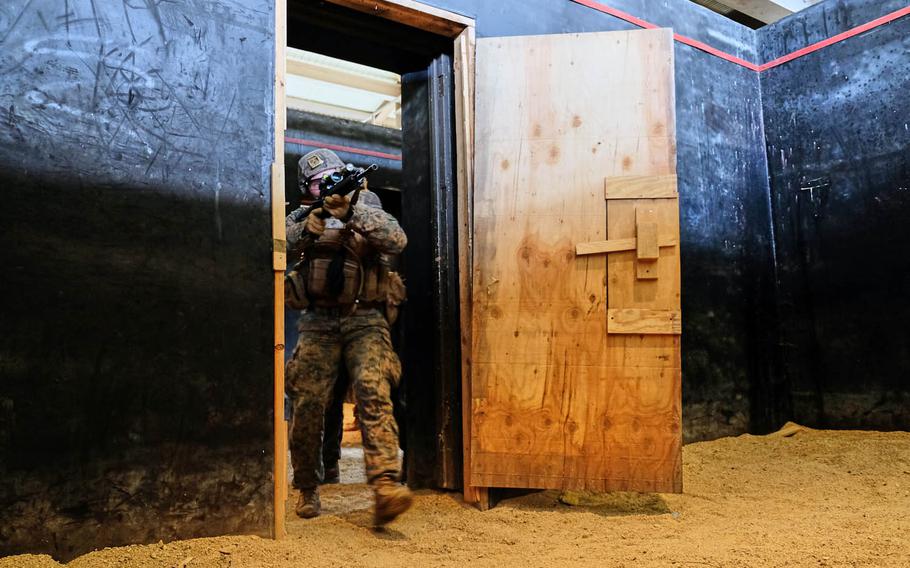
Marines from the Fleet Anti-terrorism Security Team-Pacific, Yokosuka, Japan Naval Base, train to clear rooms at Story Live Fire Training Complex, South Korea, Tuesday, Nov. 26, 2019. (Matthew Keeler/Stars and Stripes)
WARRIOR BASE, South Korea — Marines from an anti-terrorism force stationed at Yokosuka Naval Base, Japan, are honing their skills on live-fire ranges just minutes from the Demilitarized Zone in South Korea.
Over 40 Marines from the Fleet Anti-terrorism Security Team-Pacific, or FASTPAC, are living for two weeks at Warrior Base near the DMZ, the sometimes-tense border between North Korea and South Korea. The practice ranges include training areas that simulate the real-life settings in which the Marines may be called upon to ply their trade.
“The training is environmental,” said Cpl. Justin Rohn, a squad leader, on Tuesday. “Certain areas that we get stationed at just don’t have the resources available to us like Korea. Using the training facilities here gets us familiar with the environments we might end up in.”
The Marines began the first of three days’ training Nov. 25 at the New Mexico Range, part of the Story Live Fire Training Complex just a few minutes’ drive from the DMZ. The range has a live-fire shoot-house, a building in which the Marines, using live ammunition, practiced room-clearing procedures.
Inside the structure, blue and red balloons identified targets as hostile or not hostile. Marines bounded from room to room, shooting the hostiles, searching them for intelligence and marking the rooms as cleared.
“Our job … is an embassy security team, essentially,” said Rohn. “If there is any issue that might break out inside our area of operation, our job will be to secure the area. If there is any evacuation that needs to be handled, we will assist and hold it down until a larger force can get time to mobilize and get to where they need to be.”
The specialized teams are based at Yorktown, Va., but deploy for six-month rotations to various commands around the globe.
These Marines from Bravo FAST Company, 3rd Platoon, are currently deployed to the Navy’s largest fleet, which operates in the Indo-Pacific region, an area that encompasses 36 countries and half the world’s population.
Last year, the same unit was on alert as civil unrest broke out near the U.S. Embassy in Port-au-Prince, the capital of Haiti. The Marines did not deploy but were ready, nonetheless, Rohn told Stars and Stripes.
Typically, the Marines, once alerted, have 12 hours to be packed and ready to move to an airfield. Within six hours of a second call, the team may be on its way to a hot spot somewhere in the world, said platoon commander Cpt. Michael Ragonese.
“We are an alert force at our core,” he said. “We train to be on standby and be ready should we get the call to go somewhere.”
The platoon expects to be at Warrior Base until mid-December, getting more proficient at infantry tactics, combat marksmanship and with grenades.
Even so, the team could be called away any time from its training schedule to a real-world crisis, the captain said.
“This is an opportunity for us to still sharpen those skills,” Ragonese said. “We are constantly improving and constantly refining our processes. Should that call come, we are always at our most ready.”